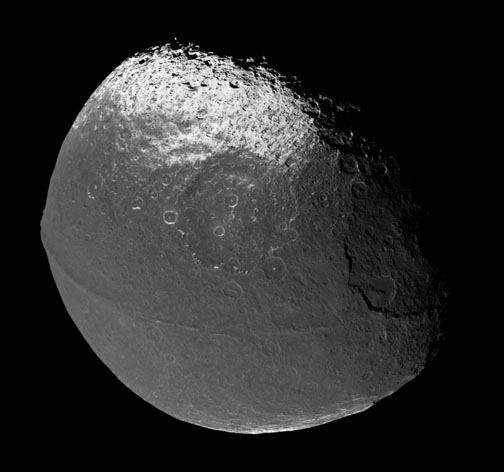![]()
There are many strange worlds that orbit the planet Saturn. One of the most curious is Iapitus. Iapitus was first noticed in 16?? by astronomer Cassinni. It apeared to him and to every future earth-bound astonomer to be winking in and out of existance as it orbited the ringed gas giant.
Iapitus was viewed by a space craft recently. The reason for the aparent winking was clear. One regon of the moon is significantly darker or lighter than the rest of it. As the moon revolves around Saturn.
There is a much more strikeing feature how ever that warrents a closer look. There is something that is being reffered to as the "equitarial ridge." This is a feature that apears to run halfway around the moon...almost exactly around the the equator. At its highest, this ridge rises 60,000 feet about the serounding terrane (that's three times higher than mount everest!) Some people say that it bears and uncanny resembleance to a walnut. Other people insist that it looks very much like the "Death Star" from a 1978 Science Fiction/Fantacy movie. What ever you compare it to, the fact remains: it seems very unlikely (to people like me) that this feature could have formed naturally.
Of course this is a big concept to wrestle with. Entertaining the notion that the ridge in question is of artifcal origin raises many questions, all of which point directly at extra terrestrial construction. This would further lead one to wonder, just what could its pourpose be? Wild speculation can provide any number of answers. The one that I came up with is based somewhat on some reading that I did a few years back.
An author named Martial T. Savage wrote a book about how he thought that human beings should go about leaveing the planet Earth and setting out to the planets and stars. One of topics that he covered was: how to get large pay-loads out of our planets gravity well. Currently, devices known as "rockets" are employed for this function. However, rockets are very, very costly. I beleive it currently costs about $10,000US to put a killogram into orbit. The cost of a space shuttle mission quickly rises above $500,000,000. M.T.Savage proposes useing something called a mass-launcher to preform the same function. A mass launcher would require a very large initial investment to build, but would, if it worked as envisioned, provide much more affordable launches to orbit.
On Earth, a mass launcher would have to occupy a tunnel underground that would be about 120 killometres. Savage says that it should be built close to the equator to utilize the same centrafusial force that most current rocket launch sites take advantage of. It should also be built leading upto and into a large mountain (Savage suggests Mt. Killamonjero in Africa) where an exit would be located. The mass launcher would have a magnetically levitateing track that ran along its length and it would need to be sealed in a vacuume. A vehical could be levitated in such an environment and accelerated to a very high velocity. It would quickly climb the mountain and shoot out of the exit and on its way to into the sky*.
Could the ridge that runs around this strange moon be a mass launcher for an alein cilivization. Could that explain the darker regon of the planet? The purpose that I speclate a mass launcher would be for in this case is lifting ice of the surface of the moon. Could an anceint inteligence stip-mined the moon of Iapitus for ice? Could such large quanities of water been used to hydrate the earth's atmosphere? Or Mars's? Speculation...
Savage says that the velocity that the vehical acheives from running through the launcher will not be enough. There-for he envisions a large block of ice being placed on the back of the vehical. After shooting out of the accelerator tunnel much, much faster than a bullet, a laser beam would be aimed at the vehical. This laser beam would flash the ice to steam and create a large amount of thrust that would push the speeding projectile even faster on its way into orbit.

![]()
 Other Iapitus Sites!!
Other Iapitus Sites!!
 This is a site that belongs to NASA. Note that the equitorial ridge is croped out of the photo.
This is a site that belongs to NASA. Note that the equitorial ridge is croped out of the photo.
 Here is the best photo of Iapitus, also from a NASA website
Here is the best photo of Iapitus, also from a NASA website
 This is a site that is not from NASA. Is is by a fellow named Richard C. Hoaglund.
This is a site that is not from NASA. Is is by a fellow named Richard C. Hoaglund.
home